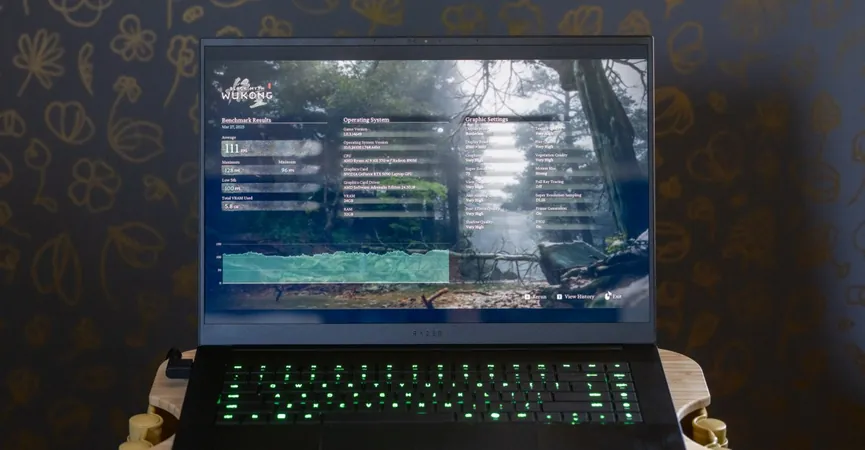
Unleashing the Power of Nvidia's RTX 5090 Mobile GPU: A Game Changer for Laptop Gamers!
2025-03-28
Author: John Tan
In the evolving landscape of gaming technology, Nvidia's latest offering, the RTX 5090 mobile GPU, aims to redefine the benchmarks for laptop performance. After facing a series of challenges with the desktop 50-series, including significant quality control issues and disappointing performance enhancements from the previous generation, Nvidia is now looking to turn the tide with its flagship laptop GPU.
Recently, I tested the RTX 5090 in Razer’s sleek Blade 16 laptop, a perfect platform for showcasing this cutting-edge mobile graphics card. Initial experiences were a bit troublesome, with my first review unit experiencing bizarre graphical glitches and unexpected crashes. However, armed with a replacement unit, I dove deep into testing, and the results are promising: compared to its predecessor, the RTX 4090, the RTX 5090 shows notable improvements in efficiency, albeit with more modest raw performance enhancements.
One of the most compelling features of the RTX 5090 is its impressive 24GB of GDDR7 VRAM, up from the 16GB GDDR6 seen in the 4090. Coupled with more powerful Tensor cores and added CUDA cores, it brings an arsenal of capabilities to gamers and content creators alike. Notably, the GPU maintains a similar thermal design power (TDP) of 175W, which is crucial for laptop performance.
In benchmark tests, the RTX 5090 didn’t just edge out its predecessor; it did so with style. For instance, it achieved a 13% increase in Geekbench scores and a 14% bump in the 3DMark Time Spy tests at a resolution of 2560 x 1440.
To put this into real-world gaming context, I conducted extensive gameplay benchmarks, primarily using titles like *Cyberpunk 2077* and *Black Myth: Wukong*. In Cyberpunk at 2.5K resolution with ultra settings (and without ray tracing or DLSS), the RTX 5090 demonstrated an impressive 24% performance increase over the 4090. However, when ray tracing and Nvidia's DLSS 4 technology were enabled, the performance gap shrank to just 5%. This nuanced shift highlights the significant impact that new enhancements in frame generation technology have on gaming experiences.
The RTX 5090 thrives when utilizing DLSS 4 Multi Frame Generation, a feature designed to produce additional frames through AI models, resulting in more fluid gameplay. But opinions remain split on this technology; while many gamers appreciate the smoother experience, others express concerns about potential increases in input latency.
On the efficiency front, the RTX 5090 impressively consumes 20-29% less power than the RTX 4090 while still delivering strong performance. This greater efficiency translates to improved battery life in portable gaming scenarios, a crucial consideration for gamers who play unplugged.
For context on pricing, the RTX 5090 is Nvidia's top-tier mobile GPU, and the flagship Blade 16 configuration will set you back around $4,499.99. As a comparison, the RTX 4090, while not as potent, may become increasingly appealing, especially with significant discounts becoming available as the new generation establishes a foothold in the market.
As we continue to explore the capabilities of the RTX 5090, it’s clear that Nvidia is making strides to enhance mobile gaming performance along with efficiency. It's a promising start, and with other models, such as the RTX 5080 on the horizon, there may be options that provide a more balanced experience for gamers as demand for high-performance mobile rigs persists.
Stay tuned for more on Nvidia's innovations, as we investigate how the gaming landscape continues to change with each new generation of GPUs.



 Brasil (PT)
Brasil (PT)
 Canada (EN)
Canada (EN)
 Chile (ES)
Chile (ES)
 Česko (CS)
Česko (CS)
 대한민국 (KO)
대한민국 (KO)
 España (ES)
España (ES)
 France (FR)
France (FR)
 Hong Kong (EN)
Hong Kong (EN)
 Italia (IT)
Italia (IT)
 日本 (JA)
日本 (JA)
 Magyarország (HU)
Magyarország (HU)
 Norge (NO)
Norge (NO)
 Polska (PL)
Polska (PL)
 Schweiz (DE)
Schweiz (DE)
 Singapore (EN)
Singapore (EN)
 Sverige (SV)
Sverige (SV)
 Suomi (FI)
Suomi (FI)
 Türkiye (TR)
Türkiye (TR)
 الإمارات العربية المتحدة (AR)
الإمارات العربية المتحدة (AR)